Risk Management Process Guidelines
22 Pages3223 Words109 Views
Added on 2021-06-14
Risk Management Process Guidelines
Added on 2021-06-14
ShareRelated Documents
Running head: RISK MANAGEMENT PROCESS GUIDELINESRisk Management Process Guidelines in business risksStudent NameUniversity Name
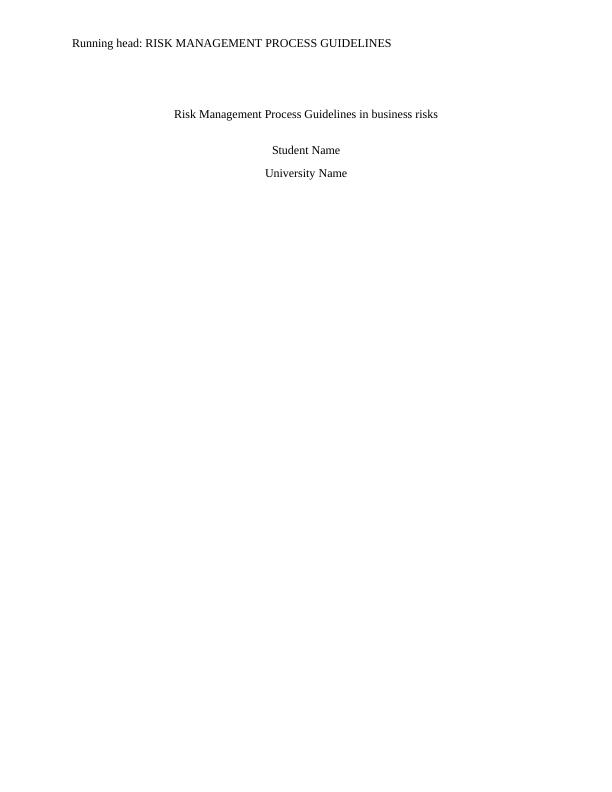
RISK MANAGEMENT PROCESS GUIDELINES2Table of ContentsIntroduction......................................................................................................................................3Step 1:- Assessing the risk-Identification of the risk.......................................................................5Step 2 - Analysis of the risk and reviewing it................................................................................10Step 3: Risk treatment plan with appropriate actions....................................................................14Step 4 Managing and Monitoring Risks........................................................................................16Step 5: Risk Closure......................................................................................................................18Conclusion.....................................................................................................................................19References......................................................................................................................................20Appendices....................................................................................................................................21
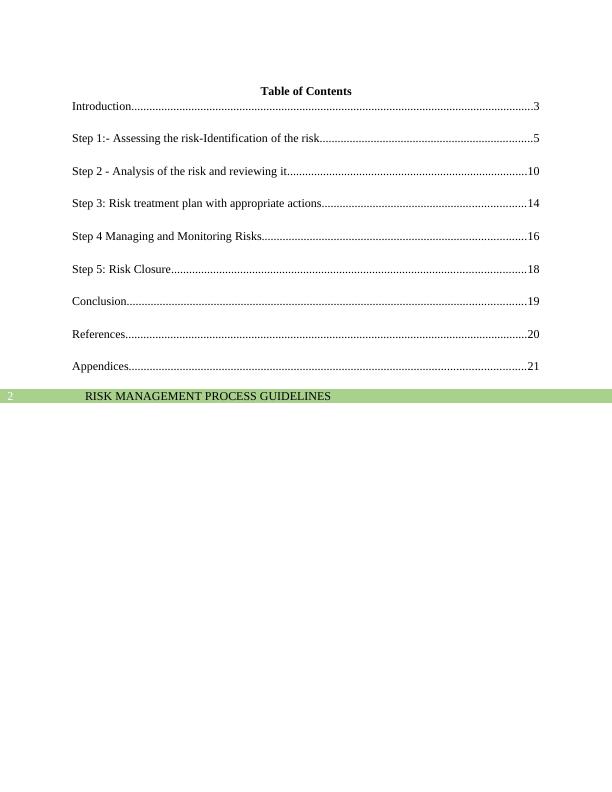
RISK MANAGEMENT PROCESS GUIDELINES3IntroductionIn modern business times, all the business organizations are driving towards sustainability due to increase in competition in the business environment. However, the biggest barrier to sustainability is risk management. If an organization is successful in effective risk management, then, they can easily be sustainable in the long-run.What is Risk?Any uncertainty behind any event of a business organization is termed as risk. There are various types of risks and different forms of risk management process that any business organization needs to trigger in order to nullify the risk (McNeil, Frey & Embrechts, 2015).What are types of risk and impact of those risks?According to AS/NZS ISO 31000:2009 Risk Management, there are various types of risks that a business organization needs to encounter (Standards Australia/Standards New Zealand Standard Committee, 2009). These are as follows:-Compliance Risk-Related to Legal TermsStrategic Risk-Deals with various short term or long term strategiesFinancial Risk- Risk related to finance and liquidityOperational Management Risks- Risk related to smooth flow of operationsGoodwill Risk-Risk of losing out the Goodwill (Glendon, Clarke & McKenna, 2016).Principles to be kept in mind for Risk Management Process1.Creates and protects value of the firm2.Be an integral part of organizational processes
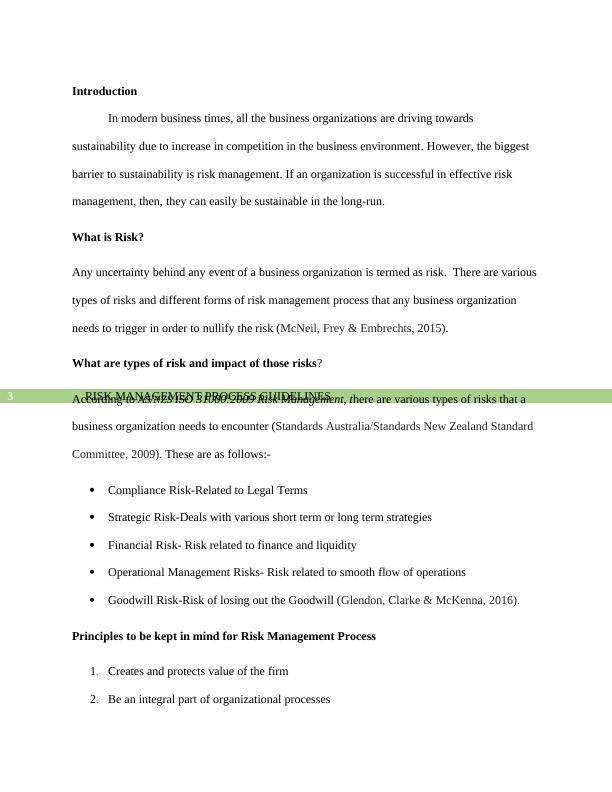
RISK MANAGEMENT PROCESS GUIDELINES43.Decision making part4.Addressing Uncertainty5.Systematic and Timely Results6.Implementation based upon best possible information7.Being Tailored8.Human and Cultural factors to be taken under consideration9.Being Transparent10.Being Dynamic11.Continuous Improvement (Sadgrove, 2016).Steps of Risk ManagementThere are various steps for risk management process. These are as follows:-Identification and assessing the riskRisk Analysis and ReviewTreating of the riskMonitoring/ Reviewing and Contingency PlanClosing the risksThis can be further explained with the help of the following figure:-
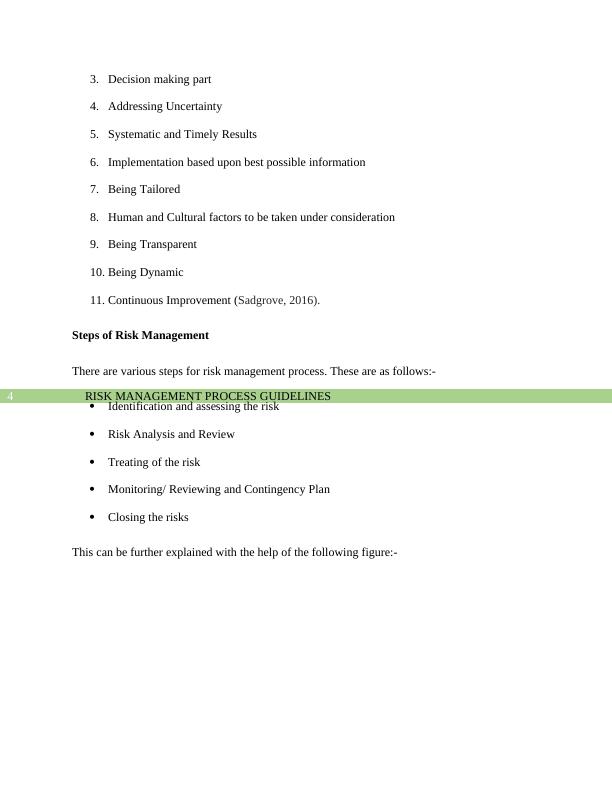
RISK MANAGEMENT PROCESS GUIDELINES5Figure 1: Steps in Risk Management Process(Source Glendon, Clarke & McKenna, 2016).Step 1:- Assessing the risk-Identification of the riskNeed for this step and its importanceIt is of great essence for any business organization to identify the required risk and take appropriate steps in order to mitigate them. The top level management of the respective business organization needs to identify the cause and the effect of the prospective risk. So how can they identify and do it?These are the possible steps:-First, the probable risk should be identified All the given risks need to be categorized according to their likelihoodThe stakeholders of the risk needs to be identified in a timely mannerIdentification and assessing the riskRisk Analysis and ReviewTreating of the riskMonitoring/ Reviewing and Contingency PlanClosing the risk
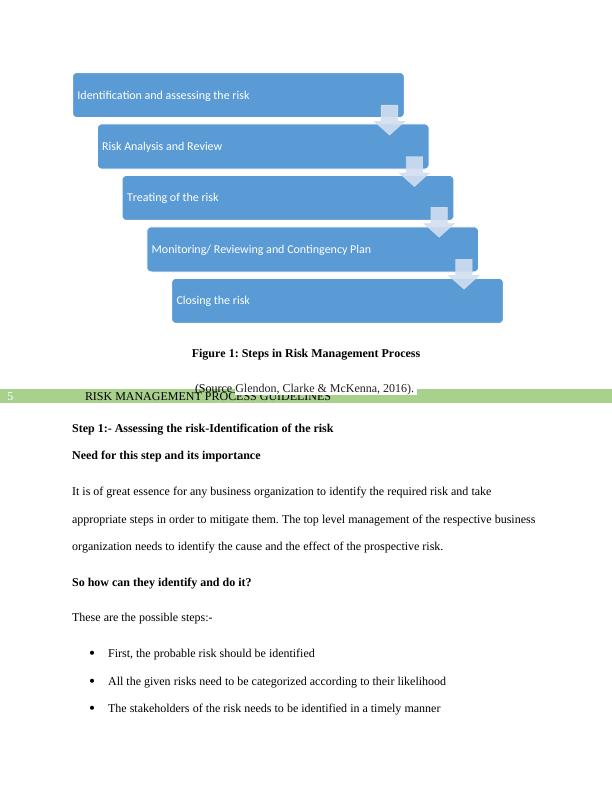
RISK MANAGEMENT PROCESS GUIDELINES6The main reason behind the risk also needs to be identified and evaluatedExisting risk management register needs to be reviewed (McNeil, Frey & Embrechts, 2015).Identification of the required riskThis given step involves the cause and effect of any particular event occurred in a particular business organization. Risk can be identified and determined with the help of the following variables1.What went wrong?2.Why it went wrong?3.What is the potential impact of the event?All the above events can be described and termed as risk. There are several ways and techniques in order to identify the risks of any particular business organization (Sadgrove, 2016). These techniques are as follows:-SWOT analysisPESTLE analysisScenario analysisChecklist360 Feedback ApproachCustomer review (Bessis, 2015).For example, the organization encountered a financial loss of $5000 due to theft due to ineffectiveness of the security system

End of preview
Want to access all the pages? Upload your documents or become a member.
Related Documents
MGMT6019– Engineering Risk Managementlg...
|13
|2537
|93
This specific process involves documentationlg...
|18
|5782
|16
Health and Safety Guidance Document for Residential Care Settinglg...
|7
|1540
|174
Risk Management for Greenville Enterprises: Examples of Legislation, Key Risks, and Action Planlg...
|15
|2362
|190
Risk Analysis and Management: ABC Pvt Ltd Companylg...
|46
|14654
|484
Risk Management: Standards, Guidelines, and Procedureslg...
|7
|1381
|96
